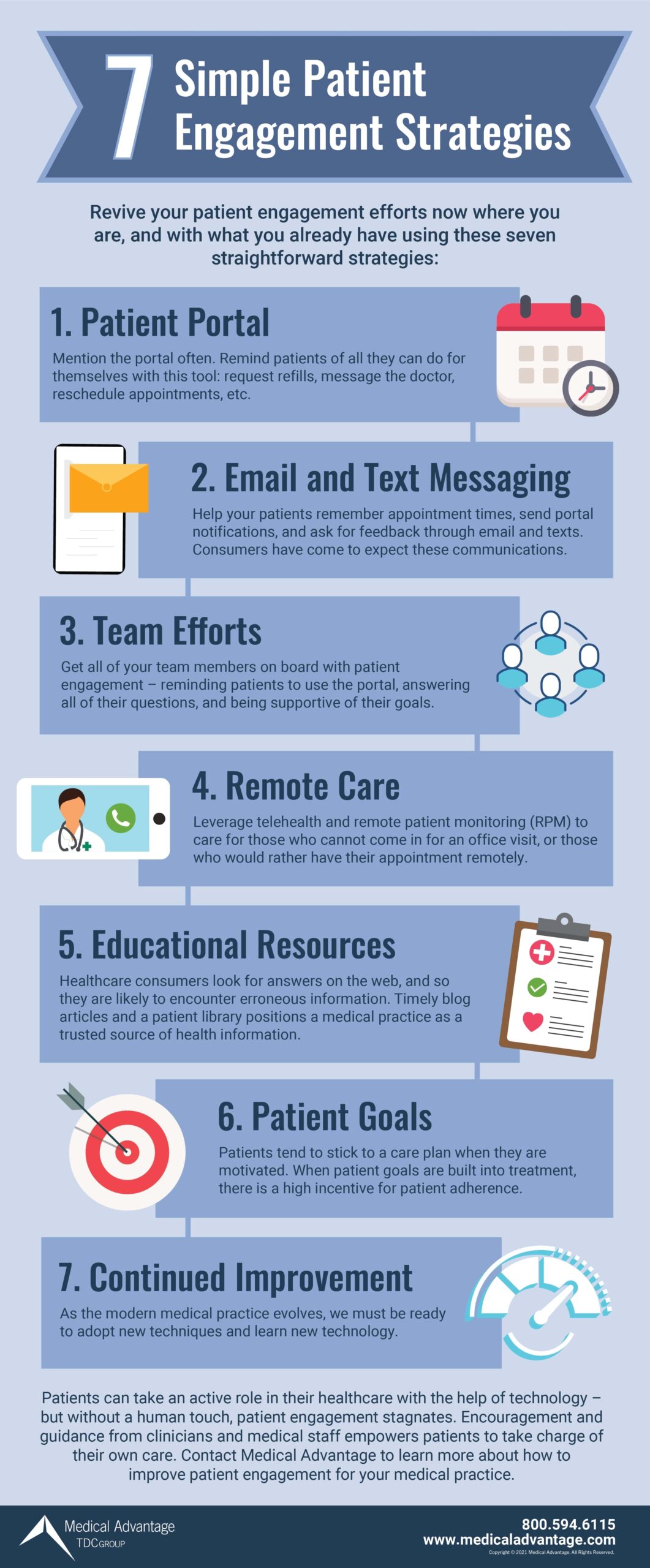Strategies for improving patient engagement include patient education, shared decision-making, encouraging patients to take initiative to learn and take ownership in their care, and monitoring patient activation levels. Putting together a patient engagement plan is the first step toward addressing low patient activation levels.
Patient activation measurement (also referred to as PAM) is an assessment of a patient’s knowledge, skill, and the level of confidence they have in managing their own healthcare. Through this measurement, providers better understand the patient’s behaviors, motivators, and attitudes at play in their care in addition to the related outcomes.
The primary benefits of patient activation and patient engagement in healthcare are:
- Gain payment adjustments through Value-Based Care/MIPS – Interventions that come about from better patient engagement have a positive impact on your bottom line.
- Nurture patient lifetime value and loyalty – Investment in patient retention secures solid and reliable revenue from customer lifetime value (CLV).
- Optimize staff workflow – When more patients are engaged, this frees up time for the staff. Patient portal self-service reduces telephone communication demand on PSRs, nurses, etc.
- Improve provider reputation – When patient engagement leads to patient satisfaction, patients are more likely to recommend a care provider. Also, pursuing patient feedback is an instrumental part of a patient engagement playbook.
- Increase quality of care – Engaged patients fare better than those who are not involved in their care. Patients who do not participate in their own health management incur up to 21% higher healthcare costs than those who are more engaged. More success stories to refer to is a meaningful key performance indicator.
Patient engagement strategies require commitment to be effective: keep working toward the goal (even if results are not seen right away) and refining your process in addressing why patients do not engage.

How Do You Improve Patient Engagement?
As we learn more about how our patients behave, see developments in technology, and observe how patients and technology work together, improving patient engagement is a work in progress. How to engage patients in their care begins with the tools already at your disposal: patient portal, email and text messaging, the medical team, telehealth, education, patient goal setting, and better communication.
1. Promote the Patient Portal at Every Opportunity
While it has been estimated that 90% of providers are equipped with a patient portal, it remains an uphill battle to get the majority of patients to utilize its valuable features. With portal-using patients being 2.6 times more likely to remain patients, promoting portal engagement is one way to nurture patient retention.
According to an Accenture survey, 68% of patients say they are more likely to choose medical providers who extend the ability to book, change, or cancel appointments online. To reconcile the gap between low participation and willingness among patients, providers can investigate why this chasm exists in the first place.
A Look at Why Patients Avoid Accessing Information Through the Portal
An ONC medical records report finds that 63% of patients accessed their medical records online when encouraged to do so versus only 38% who did so without being prompted. Reasons for patients not accessing their medical records online include:
76% prefer to speak to their provider directly
59% did not see it as necessary
25% were unsure of their privacy/security when accessing records online
20% report not having a way to access it online
19% no longer have an online record
Providers can start by addressing the top two answers affirmed by most respondents. For example, you can remind patients that they can communicate with their provider through the portal messaging system and that this bypasses the many steps of telephone (waiting to leave a message with a nurse to get a call back). You also might need to remind patients of the value of portal use and all they can do online: schedule appointments, get lab results, request prescription refills, review visit notes, etc.
2. Utilize Emails and Text Messages to Encourage Use of the Patient Portal
It has also been reported in survey results that over half of the respondents expect text messages, voice mails, or email reminders from a medical practice reminding them to schedule an appointment or take medications. This indicates that many want to see an increase in patient engagement from their providers. If you have seen your missed appointments occurrence greatly reduced from automated reminders, you have already achieved a patient engagement victory.
Increasing patient engagement can be approached by encouraging more patient opt-in or by slightly expanding this service so that your patients hear from you more often. Email lists are perfect for sending out newsletters, invitations to upcoming educational events, seasonal reminders (back-to-school physicals, flu shots, etc.), and to encourage patient portal use. Email and text messages also are a way to request feedback from patients via surveys and online reviews.

3. Make Your Patient Engagement Strategy a Team Effort
All interactions between medical practice and patients have an impact. The more guidance and encouragement patients receive from the practice team, the more empowered they are to get involved in their own care. For example, offering a way for patients to sign up for the portal in person can raise engagement and enrollment numbers.
Patient engagement strategies are better formed with input from your care staff. Medical practices should consider holding weekly team meetings and staff training for ongoing collaboration and coaching for patient engagement objectives.
Foster a patient engagement mission by exploring ways to make it fun for staff, including competitive gamification, employee performance review inclusion, and rewarding your team when goals are reached. With all hands on deck for patient engagement strategy implementation, it won’t be long before all patients are well aware of their opportunities to be more active in their healthcare.
“Make sure that the staff understands why they are doing this outreach to the patients.” Medical Advantage Managing Consultant Sarah Saj on how to secure staff buy-in when improving patient engagement.
4. Capitalize on Telehealth to Improve Patient Engagement
Since 2020, we have seen telehealth increase patient engagement in a significant way. Patients and providers are better acclimated to telemedicine, especially for behavioral health services.
Telehealth is an opportunity to better serve patients, so consider offering this solution whenever feasible as it helps high-risk patients or those with transportation issues to better engage. Knowing that this option is available for their convenience is instrumental for improving patient engagement.
5. Provide Guidance Through Education Resources
It has been reported that 72% of consumers use the internet to search for healthcare information. There lies an opportunity to support and encourage knowledge-hungry patients by providing them with credible and readily accessible resources via articles, webinars, newsletters, workshops, and more.
Medical Advantage recently joined forces with iHealthSpot to create a Practice Marketing solution that further promotes patient engagement through patient education libraries available to our clients on their medical websites.
83% of seekers are skeptical of medical information they read on social media. However, you can be the voice the reason and establish authority by leveraging social media channels to dispel myths and misinformation surrounding trending health topics.

6. Encourage Patient Engagement Through Personal Goal Inclusion
Becker’s Hospital Review reports that patients are more likely to stick to a care or treatment plan if they are working toward a personal goal. During encounters with patients, ask open-ended questions to encourage a dialog about their struggles and desires.
Whenever possible, frame a treatment plan around their individual goals. Motivation rooted in the aspirations and emotions of the patient both nurtures and incentivizes patient engagement.
7. Refine Communication Methods for Better Patient Experience
Becker’s Hospital Review also reported that bedside manner matters greatly to patients. The better a clinician is at communicating with patients, the more trust they establish so patients feel better supported in their healthcare goals. Make a point to recruit team members who are committed to compassionate communication.
Two ways to achieve a better patient experience are the inclusion of scribes and a continuous refinement of communication tactics. Virtual scriber services can free clinicians to be more present with patients as a remote scribe takes all the notes for them. On the other hand, consider communication improvements such as behavioral interviewing or other healthcare communication strategies that reinforce a patient’s care matters greatly.
Recap of 7 Simple Patient Engagement Strategies
The healthcare community will continue to uncover ways to increase patient engagement, so the list of ways to improve patient engagement will continue to grow. A few patient engagement strategies include:
- Consistently promote the portal: The patient portal is your best tool in encouraging patients to take ownership of their healthcare. Promote it as much as possible.
- Expand usage of electronic communication channels: Leverage text messaging and email to keep the lines of communication active with your patients.
- All hands on deck: The drive for patient engagement begins with better staff training – make everyone a stakeholder in this effort.
- Embrace telehealth: Telemedicine is here to stay, so use it whenever it keeps patients engaged.
- Be the go-to for information: Your patients will encounter dubious claims on the internet, so arm them with credible information.
- Consider the patient’s personal goals: Set your patients up for success by aligning their treatment plan with their own personal goals.
- Continuous communication improvement: Commit to a patient engagement plan that includes ongoing adoption of communication improvements.

Medical Advantage Can Help Keep Your Patients Engaged
It is no secret that patient engagement is a pathway to healthcare success and helps encourage patient retention and loyalty. In many ways, both patients and providers benefit from patient engagement in healthcare.
Because Medical Advantage is committed to helping practice managers and clinicians deliver efficient high-quality healthcare, we offer several areas of support for your patient engagement strategies:
- Healthcare Consulting: We optimize your Value-Based Care operations.
- Telehealth Consulting: We enable you to keep pace with the telemedicine revolution.
- Care Management and RPM: We improve engagement and optimal outcomes for high-risk patient populations.
- Practice Marketing: We create engaging medical websites that make the portal easy to access, helping you attract new patients as well as retain and educate patients through a patient education library and regular social media posts.
Set up a consultation today to explore all your opportunities for an effective patient engagement plan.



